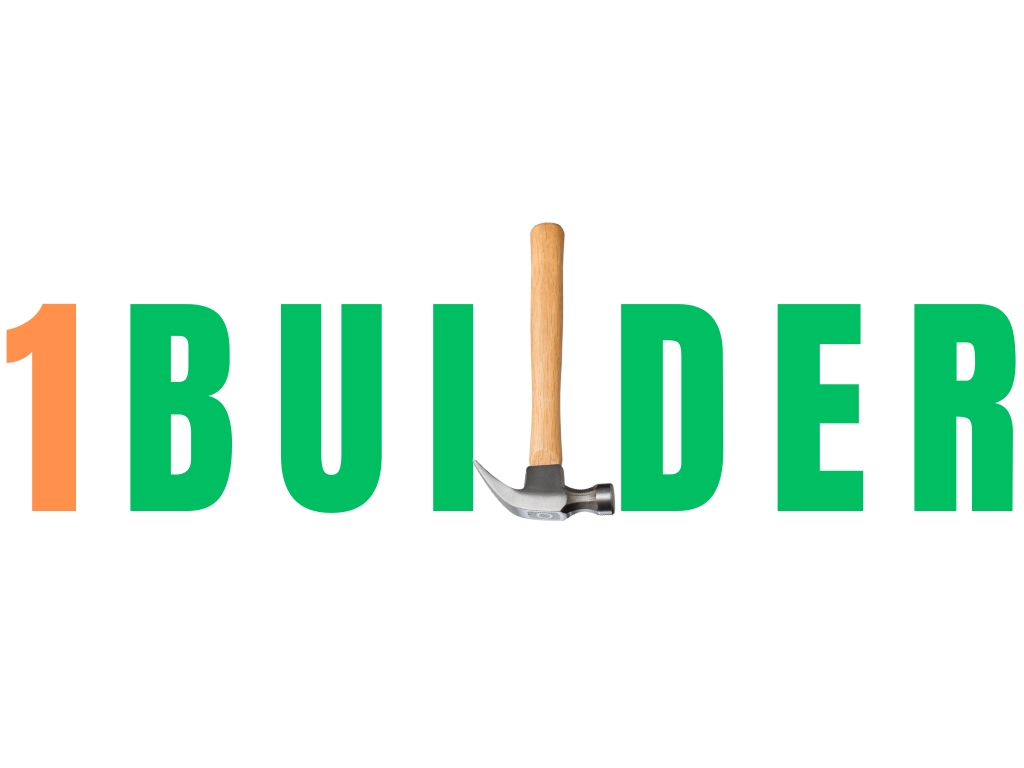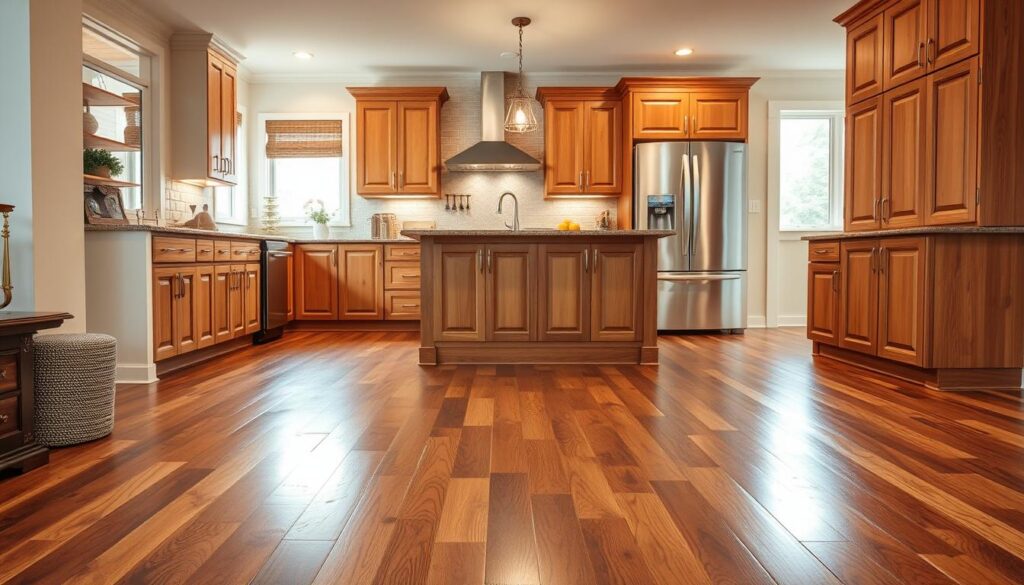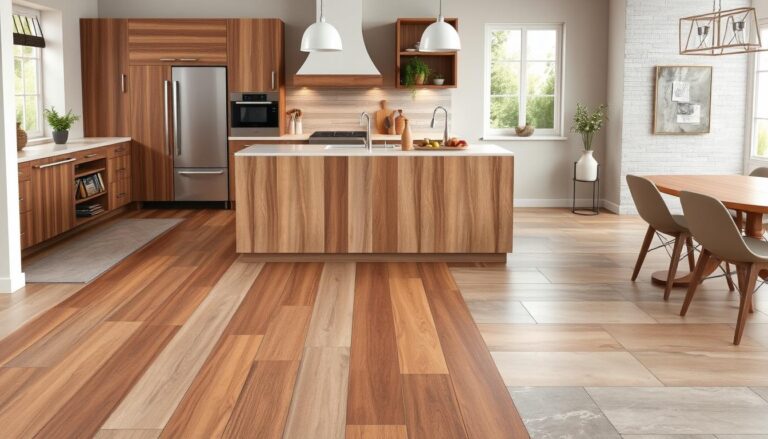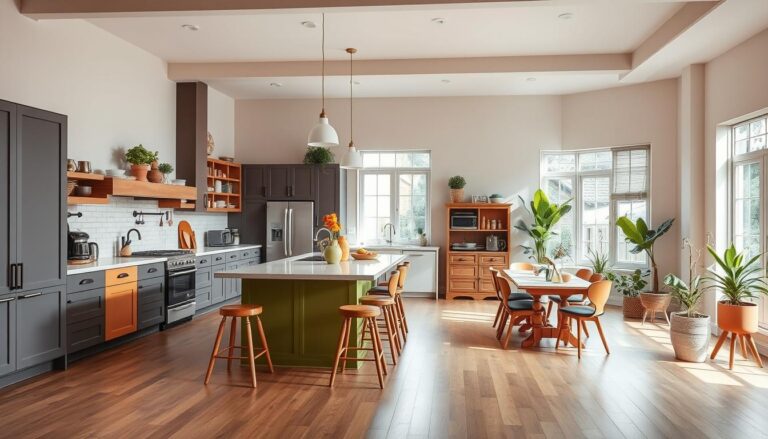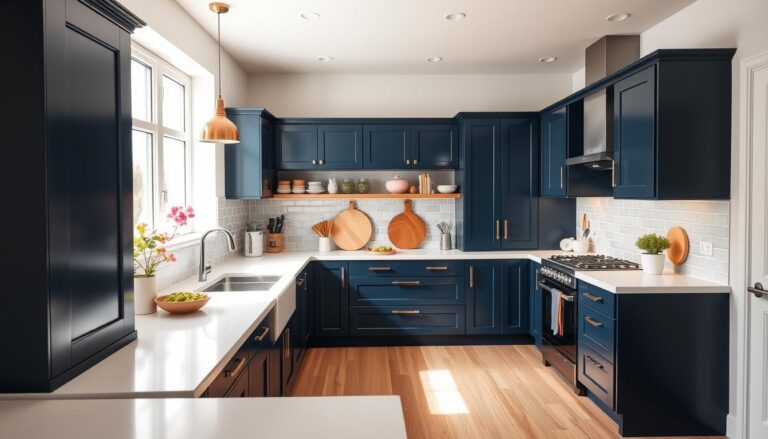Thinking of combining elegance, durability, and practicality in your kitchen makeover? Hardwood flooring might be the answer. It comes from strong trees like oak and ash. It adds strength and style to your space. You can choose hardwood flooring whether you want a modern or rustic kitchen.
Solid unfinished planks can last more than 100 years. They offer great protection against water and stains. Prefinished options are easier to install but can be tricky in damp places like kitchens. Engineered planks are stable and easy for DIYers, perfect over concrete. For an eco-friendly choice, reclaimed planks are ideal, but they must be installed right.
Hardwood flooring is loved for its long-lasting beauty and toughness. It’s also a smart investment that boosts your home’s value. Yet, it must be installed correctly to protect against moisture. Over time, scratches can damage the finish, so upkeep is important. Even with these issues, hardwood remains a top choice for a cozy, attractive kitchen.
Key Takeaways
- Solid unfinished planks provide the best water damage and staining protection, lasting over a century.
- Engineered planks offer a stable, DIY-friendly option, ideal for concrete installation.
- Reclaimed planks are an eco-friendly choice if installed correctly.
- Hardwood flooring enhances home value, providing visual warmth and natural appeal.
- Proper maintenance is crucial to prevent scratches and compromise of the seal coat.
Benefits of Hardwood Flooring in the Kitchen
Hardwood flooring is getting more popular in kitchens. It’s durable, looks great, and can boost your home’s value. Here, we’ll see why it’s a smart pick for your kitchen redo.
Durability and Longevity
One big plus of hardwood flooring in the kitchen is its durability and longevity. Floors made of oak and maple are tough. They handle a lot of walking and drops, perfect for kitchens.
The National Association of Realtors says that new hardwood floors can give you back 118% of what you spend. And if you fix up the floors you already have, you could see a 147% return. Good care means wood floors last 20-30 years, much longer than carpet or laminate.
Aesthetic Appeal
Hardwood floors look amazing in kitchens. You can pick from many types of wood, like grainy oak or subtle maple. Depending on the look you want, you can go rustic or modern.
They add warmth and elegance, making any decor style shine. If you have an open-concept home, hardwood floors link spaces together. They make your house feel connected and welcoming.
Increased Home Value
Last, hardwood floors can up your home’s selling price. Houses with wood floors sell quicker and fetch higher prices.
Buyers see them as a mark of quality and care. So, putting in hardwood floors is a smart move. It makes your space better to live in and can pay off if you sell.
Choosing the Right Hardwood Species
When you’re redoing your kitchen floors, picking the right wood is key. Kitchens get a lot of foot traffic. They also see their fair share of spills and drops. So, you need wood that’s tough and can handle it all.
Popular Species for Kitchens
Oak, maple, and cherry lead the pack for kitchen floors. They’re strong and look great in any setting. Red oak is a winner for those with pets or a bustling home because it doesn’t scratch easily.
Hardness and Resilience
Hardwood species have different strength levels. This strength is measured by something called the Janka rating. It tells us how well a wood can resist dents and wear. For instance, red oak has a Janka rating of 1290. White oak is a bit tougher at 1360.
Hickory and Brazilian cherry are even stronger, with ratings of 1820 and 2350, respectively. Their toughness makes them perfect for kitchens. On another note, engineered wood is a smart choice, too. It deals with humidity better than solid wood, which is great for a kitchen.
Color and Grain Variations
Hardwood comes in many colors and grain patterns. There are curly, straight, and flat grain patterns. Light floors, like those made of ash or maple, hide dirt well. They also make your kitchen look brighter.
Meanwhile, dark floors offer a cozy vibe and match various kitchen styles easily. Lighter floors, including those with a white-washed look, are becoming more popular. So are matte finish floors, which show less dirt and scratches. Techniques like wire brushing give wood floors a unique, rustic feel, making any imperfections less noticeable.
| Wood Species | Janka Rating | Color and Grain | Special Features |
|---|---|---|---|
| Red Oak | 1290 | Warm tones, straight to curly grain | Scratch-resistant, ideal for pet owners |
| White Oak | 1360 | Cooler hues, straight grain | Highly durable and water-resistant |
| Hickory | 1820 | Varied colors, bold grain pattern | Extremely hard, great for high traffic |
| Brazilian Cherry | 2350 | Rich, dark tones, exotic grain | High resilience, luxurious appeal |
Installation Process of Hardwood Flooring
When adding hardwood floors to your kitchen, you need to know the steps involved. We’ll help you grasp the key phases and tips for a flawless hardwood floor install in your kitchen.
Preparing Your Kitchen Space
First, get your kitchen ready for the new floors. Make sure the subfloor is smooth, stable, and clean. Take out any old flooring and check the moisture level. This helps avoid wood problems later.
Underlayment and Moisture Barrier
It’s critical to install an underlayment and a moisture barrier. They guard the wood against moisture damage. A felt underlayment paired with a plastic barrier best protects and insulates.
Professional vs. DIY Installation
Choosing between a pro doing the work or tackling it yourself is a big decision. Pros bring precise skills, perfect for complex jobs. Yet, skilled DIYers can successfully install, especially with engineered woods and click-lock methods.
| Installation Method | Usage Percentage | Best For |
|---|---|---|
| Nail-Down | 70% | Solid Hardwood Floors |
| Click-Lock | 20% | Engineered Wood Floors |
| Glue-Down | 5% | Engineered Flooring |
| Staple-Down | 5% | Initial Strong Hold |
Focus on these key steps and pick the right install method for you. This will make your kitchen look better and ensure the floors last a long time.
Maintenance Tips for Hardwood Floors
Proper maintenance of hardwood flooring in kitchen places is important for looks and lasting use. With routine care, you can protect your hardwood floors. Here are essential tips to keep them looking great.
Daily Care and Cleaning
Daily cleaning is key for hardwood floor care. Sweep or vacuum every day to get rid of dirt and hair. This stops scratches. Use warm water and Murphy Oil Soap for a gentle clean. Avoid products that promise shine, as Brett Miller warns. They can harm polyurethane finishes.
Preventing Damage and Scratches
To avoid damage, take some preventive steps. Put felt pads under furniture to stop scratches. Use mats at doorways to keep dirt off the floors. Stay away from chlorine and harsh chemicals. They damage the wood and make it look cloudy.
Refinishing and Restoring
Refinishing your floors every 5 to 10 years makes them look new. This includes sanding and applying a sealant for protection. For top-notch work, seek experts in Southern California, such as San Fernando Valley, San Diego, and San Marcos. They know how to handle kitchen hardwood floors.
Acclimation of Hardwood Flooring
To install hardwood floors successfully, you must start with acclimation. This important step makes sure the wood gets used to your home’s indoor climate. Doing this prevents unpleasant issues like warping, gaps, and moisture problems after the floors are installed.
Importance of Acclimation
Acclimation is key to ensure the wood’s moisture matches the home’s atmosphere. Wood floors are dried to a 6-9% moisture content, fitting for most homes. Yet, new homes with lots of humidity can make the wood cup in just 48 hours. So, for hardwood floor setup, it’s critical the wood adjusts to the space’s conditions first.
Steps for Proper Acclimation
Proper acclimation follows these steps:
- Bring the hardwood flooring to where you’ll install it two weeks prior.
- Keep your home’s humidity (30-50%) and temperature (60-80°F) stable.
- Stack the flooring boxes in a criss-cross pattern to let air flow.
- Check that the flooring and subfloor moisture levels are no more than 2% apart before laying the floor.
Ideal Conditions for Acclimation
Different places need different acclimation. For example, in dry areas like Alberta or Arizona, wood has to get used to less moisture to stop gaps. But in humid coastal places, the wood needs to take in moisture to avoid getting bigger and cupping. The goal is to get the moisture content right for everyday home living. When done well, it helps avoid problems like shrinking, expanding, or splitting.
| Region | Acclimation Requirement |
|---|---|
| Dry Regions (Alberta, Arizona) | Adjust to drier conditions to prevent gaps |
| Humid Coastal Areas | Absorb moisture to prevent expansion and cupping |
Cost Considerations for Hardwood Flooring
When planning hardwood flooring for your kitchen, think about various costs. This ensures you stay within budget.
Average Costs for Materials
The average cost of hardwood floors is usually $7 to $15 per square foot. Wood types like oak, maple, and cherry change the cost. It’s crucial to think about wood quality and thickness, as they affect the price.
| Flooring Material | Average Cost per sq ft |
|---|---|
| Hardwood Flooring | $7 – $15 |
| Laminate Flooring | $3 – $8 |
| Carpet Flooring | up to $3 |
| Ceramic Tiles | $3 |
| Porcelain Tiles | $5 – $10 |
| Marble Flooring | $5 – $20 |
| Granite Flooring | $2 – $40 |
| Slate Tiles | $10 – $16 |
Installation Expenses
Installation costs are a big part of your project’s total cost. On average, installation expenses are $3 to $10 per square foot. This leads to a total of $1,500 to $4,500 for an average kitchen. The complexity and if you hire a pro or DIY will change costs.
For example:
- Estimated cost to install hardwood in a 161-square-foot kitchen: $1,100 to $2,400.
- Laminate flooring for a 161-square-foot kitchen: $500 to $1,600.
Budget-Friendly Alternatives
If you are budgeting for kitchen hardwood floors, think about other options. Engineered wood costs less than hardwood but looks similar. Laminate is cheaper, between $3 and $8 per square foot, and easy to put in.
Vinyl and linoleum also offer good value. They cost $3 to $10 per square foot. They’re durable, great for busy kitchens, and keep you on budget.
Eco-Friendly Options for Hardwood Flooring
Today, more people want to make their homes green. Choosing eco-friendly hardwood floors is vital. Such choices are good for the planet and make our homes healthier.
Sustainable Hardwood Choices
Bamboo and reclaimed wood are top picks for sustainable floors. Bamboo grows back fast, in just 3 to 5 years, and doesn’t have harmful chemicals. Reclaimed wood, which is recycled, also reduces the environmental impact.
Certifications to Look For
Look for certifications like the Forest Stewardship Council (FSC). They show the wood comes from forests that are well cared for. FSC-certified wood is durable and good for the earth. Engineered wood is another green option because it doesn’t create waste like solid wood does.
Benefits of Eco-Friendly Flooring
Choosing eco-friendly floors has many benefits. Options like cork, bamboo, and linoleum are kind to the earth. They are strong, look great, and come with added benefits. For example, cork is resistant to water, wards off bugs, and quiets noise.
Bamboo cleans the air by absorbing CO2, grows back quickly, and is easy to keep up. Linoleum is made from natural materials, breaks down over time, and keeps your air cleaner.
Here are the key features of popular eco-friendly flooring materials:
| Flooring Material | Key Features |
|---|---|
| Bamboo | Fast-growing, absorbs CO2, formaldehyde-free |
| Cork | Renewable resource, water-resistant, sound-absorbent |
| Linoleum | Biodegradable, VOC-free, natural materials like flaxseed oil |
| Reclaimed Wood | Recycled product, durable |
| Engineered Wood | No sawdust during production, environmentally friendly |
When choosing eco-friendly hardwood floors, think about their durability, how they work in your space, their cost, and their impact on the environment. These factors will help you make the best choice for your green kitchen.
Trends in Kitchen Hardwood Flooring
Kitchen renovations see ever-changing hardwood flooring trends, giving homeowners many options. These options enhance both the kitchen’s look and its use. We will look at the newest design trends, combining different materials and styles, along with top finishes and colors.
Current Design Trends
Wide plank floors with rustic finishes are big in kitchen updates now. They make any kitchen warm and welcoming. More people are also choosing tougher woods like White Oak and Hickory. These woods stand up well to heavy kitchen appliances.
Mixing Materials and Styles
Now, mixing hardwood with materials like tile and stone is popular for kitchens. These combos create eye-catching patterns and have practical perks. For moisture-heavy areas, using engineered wood can reduce swelling and shrinking. Also, bamboo and cork floors are in due to their strong moisture resistance and toughness.
Popular Finishes and Colors
Wire-brushed hardwood floors are great for kitchens. They hide wear well. Finishes that are light and not too shiny help hide scratches. This is good for busy kitchens. And now, people prefer rich wood colors like cherry and maple over traditional oak stains.
| Material | Benefits |
|---|---|
| White Oak | Durability, classic appearance |
| Hickory | Hardness, resistance to dents |
| Engineered Wood | Moisture resistance, stability |
| Bamboo | Hardness, eco-friendliness |
| Cork | Shock-absorbent, antibacterial |
| Concrete | Versatility, durability |
Common Mistakes to Avoid
Knowing the common mistakes in hardwood floor installation is key for your investment’s life and health. Mistakes like not planning for upkeep, choosing the wrong wood, or bad installation can harm your floor’s durability and look.
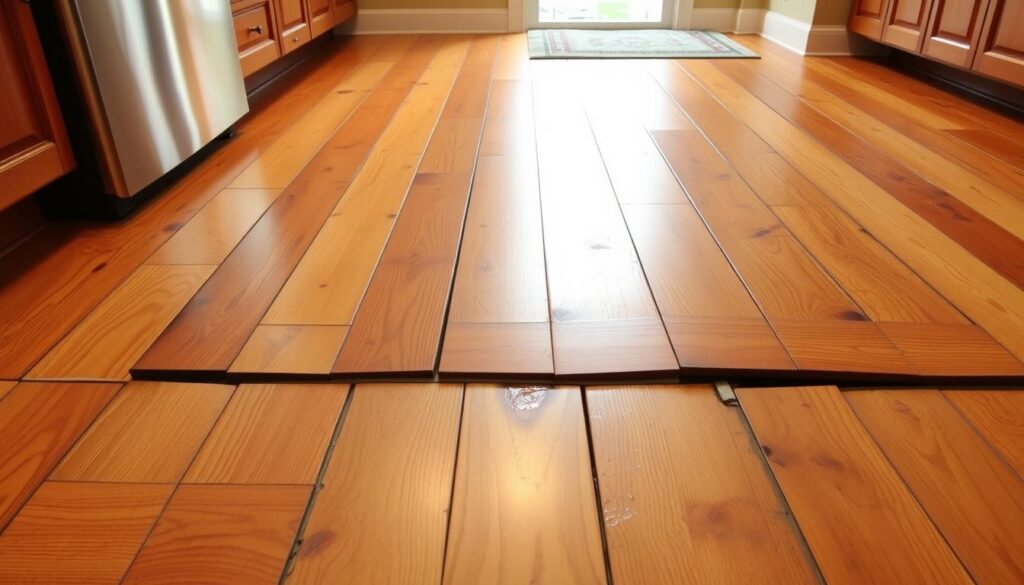
Underestimating Maintenance
Many owners don’t realize how much care hardwood floors need. By properly maintaining your floor, you can increase its life by half. If you neglect it, you’ll see quicker wear and tear, which ruins the look and value of your space. Regular cleaning and occasional refinishing keep your floor looking great.
Incorrect Installation
Problems with hardwood floors often come from wrong installation. Trying to install floors yourself can lead to errors 50% of the time. Poor planning and not hiring professionals result in uneven floors, gaps, and bad alignment. Make sure the subfloor is ready and use the right underlayment to avoid problems down the line.
| Error | Percentage |
|---|---|
| Inadequate Planning | 80% |
| Water Damage (Subfloor Issues) | 30% |
| Incorrect Material Selection | 40% |
| DIY Errors | 50% |
Choosing the Wrong Type
Choosing the wrong hardwood floor type can cause big issues later. Always think about durability, maintenance, and how the floor fits your kitchen’s style. Around 40% of homeowners regret their choice due to early damage. Pick a sealed wood that’s right for kitchens to ensure it lasts a long time.
Conclusion: Making the Right Choice
Choosing the right hardwood flooring for your kitchen is a process. It involves a mix of style, durability, and budget considerations. With a range of colors, patterns, and finishes, homeowners can find the perfect fit. Whether rustic, modern, or traditional, there’s something for every taste. Hardwood floors are a solid investment thanks to their long life span.
Recap of Key Points
We’ve looked at the benefits of using hardwood flooring in kitchens. Its durability, beauty, and value-adding qualities stand out. Choosing the right type and finish is crucial. So is ensuring it’s installed and maintained correctly. Hardwood’s resistance to water damage and ease of cleaning make it practical for kitchens.
Final Thoughts on Hardwood Flooring
Don’t forget to protect your hardwood floors with moisture barriers and felt pads. While the initial cost is higher, its long-term value due to durability and the possibility of refinishing makes it worth it. Compared to the benefits, hardwood flooring is a smart, cost-effective choice.
Encouragement to Explore Options
With all the information on kitchen hardwood flooring, you’re ready to explore your options. Look into different hardwood types that meet your design goals and needs. Whether it’s the warmth of cherry or the sleek look of maple, there’s plenty to choose from. Make a choice that will elevate your kitchen into a space of elegance and enduring quality.
FAQ
What are the benefits of hardwood flooring in the kitchen?
Hardwood floors are great for kitchens. They last long, look beautiful, and even up your home’s value. You can sand and refinish them to make them look new again. This makes them a smart choice for a stylish home.
Which hardwood species are popular for kitchen renovations?
Oak, walnut, and ash are top picks for kitchen floors. They offer different colors and patterns. This lets people choose what goes best with their kitchen’s style, while being tough for busy spots.
What is involved in the installation process of hardwood flooring in the kitchen?
Installing hardwood floors starts with a flat, stable subfloor. You’ll need underlayment and moisture barriers. Decide if you want a pro to do it or if you’re doing it yourself. Doing it right means no damage and floors that last.
How should I maintain my hardwood floors in the kitchen?
Keep floors clean with daily sweeping or vacuuming. Protect them by using felt pads under chairs and tables. Sometimes, refinishing is needed to keep them looking good and safe from wear.
Why is acclimation important when installing hardwood flooring in the kitchen?
Acclimation stops the floors from warping later. The wood gets used to your home’s air. It should sit in your kitchen for a bit before installation, under normal temperature and humidity. This makes sure it fits well and lasts.
What factors should I consider when budgeting for hardwood flooring in a kitchen renovation?
Think about the cost of the wood itself and how much installing it will be. Costs can change based on how complex your kitchen is and if you hire someone or do it yourself. Engineered wood can be less pricey and still look amazing.
What are some eco-friendly options for hardwood flooring?
Bamboo and reclaimed wood are green choices. Choosing products certified by the Forest Stewardship Council (FSC) is a good move. These options are as durable and good-looking as traditional wood, but better for the planet.
What are the current trends in hardwood flooring for kitchens?
Today, people love wide planks and rustic finishes. Some are mixing wood with tiles or stone. From shiny to distressed, there’s a trend for every taste. Colors range from natural to deep stains.
What are common mistakes to avoid when installing hardwood flooring in the kitchen?
Don’t underestimate how much care floors need. Make sure they’re installed correctly and pick the right wood for your kitchen. Avoiding these errors saves money and keeps your floors in top shape.
Source Links
- https://www.thespruce.com/hardwood-floor-in-a-kitchen-1821883
- https://www.nationalfloorsdirect.com/learn/articles/What-Is-the-Best-Hardwood-Floor-for-a-Kitchen
- https://www.lxhausys.com/us/blog/the-best-kitchen-flooring-options-for-remodeling/
- https://wideplankflooring.com/blog/the-benefits-of-installing-hardwood-in-the-kitchen/
- https://www.neilkelly.com/blog/six-benefits-of-hardwood-flooring/
- https://www.woodandbeyond.com/blog/wood-floors-in-kitchen-pros-and-cons/?srsltid=AfmBOoovr-X6-rKrk9IGbK6VwsO6fZysxY14piYdIuyDVzkWLwNtuXJ6
- https://www.visionarycabinetry.com/how-to-pick-out-hardwood-flooring-for-a-remodel.php
- https://cameronthesandman.com/how-to-choose-wood-flooring-for-a-kitchen-mi-hardwood-flooring-services/
- https://www.lowes.com/n/how-to/install-a-solid-hardwood-floor
- https://www.thisoldhouse.com/flooring/21311912/how-to-install-hardwood-floors
- https://www.homedepot.com/c/ah/how-to-install-hardwood-flooring/9ba683603be9fa5395fab9069698e54
- https://kitchenemp.net/5-tips-to-maintain-the-wooden-flooring-of-your-kitchen/
- https://www.architecturaldigest.com/story/how-to-clean-and-maintain-hardwood-floors
- https://www.gaylordhardwoodflooring.com/blogs/gaylord-hardwood-flooring/how-long-do-hardwood-floors-need-to-acclimate-answers-here
- https://portercraft.com/how-to-acclimate-solid-hardwood-the-right-way/
- https://www.blockrenovation.com/guides/cost/how-much-does-new-flooring-cost-in-a-kitchen
- https://kitchenandbathshop.com/cost-kitchen-flooring/
- https://www.michaelnashkitchens.com/sustainable-kitchen-flooring-options/
- https://www.flooringstores.com/a/blog/eco-friendly-flooring
- https://www.greenbuildingsupply.com/All-Products/Sustainable-Flooring
- https://www.gaylordhardwoodflooring.com/blogs/gaylord-hardwood-flooring/2024-flooring-trends-hardwood-in-kitchens
- https://missionkb.com/kitchen-flooring-trends-moving-beyond-the-traditional/
- https://www.flooringamerica.com/blog/5-flooring-renovation-mistakes-to-avoid
- https://kitchenandbathshop.com/kitchen-flooring-mistakes/
- https://www.architecturaldigest.com/story/dream-kitchen-renovation-mistakes
- https://www.diazhardwoodfloors.com/hardwood-flooring-in-kitchens/
- https://napervilleroofingandconstruction.com/blog/kitchen-flooring-ideas-tile-vs-hardwood-pros-and-cons/
